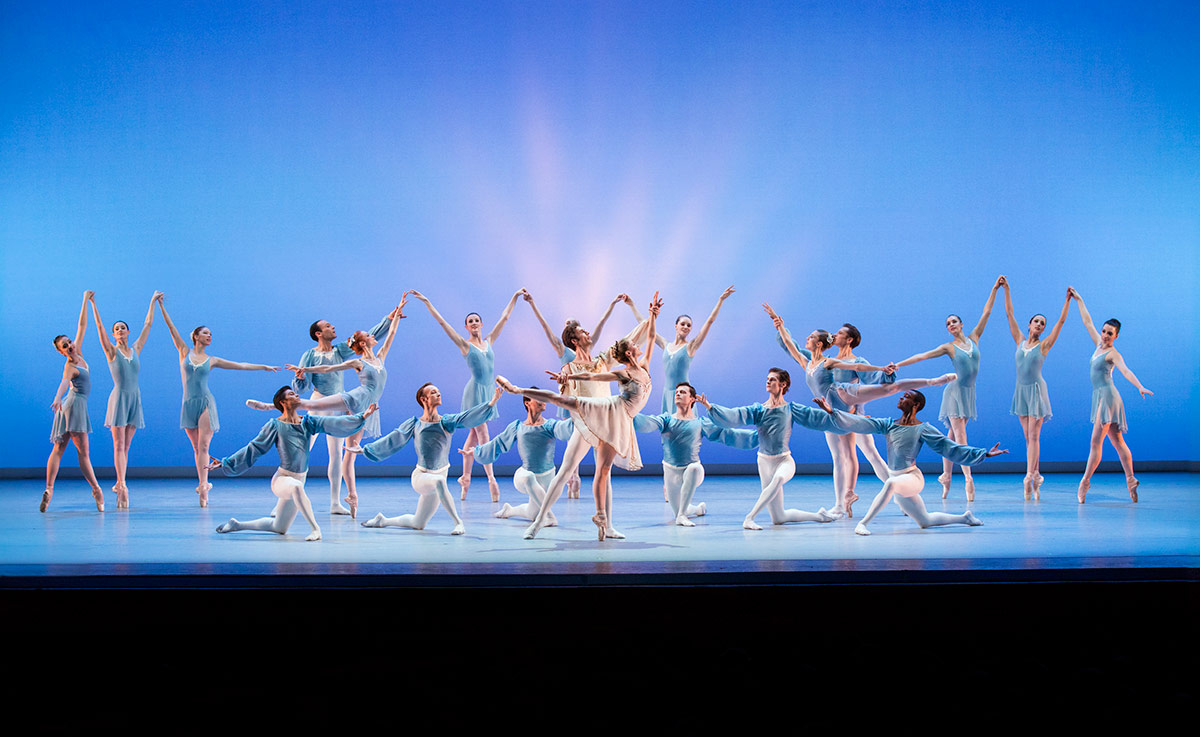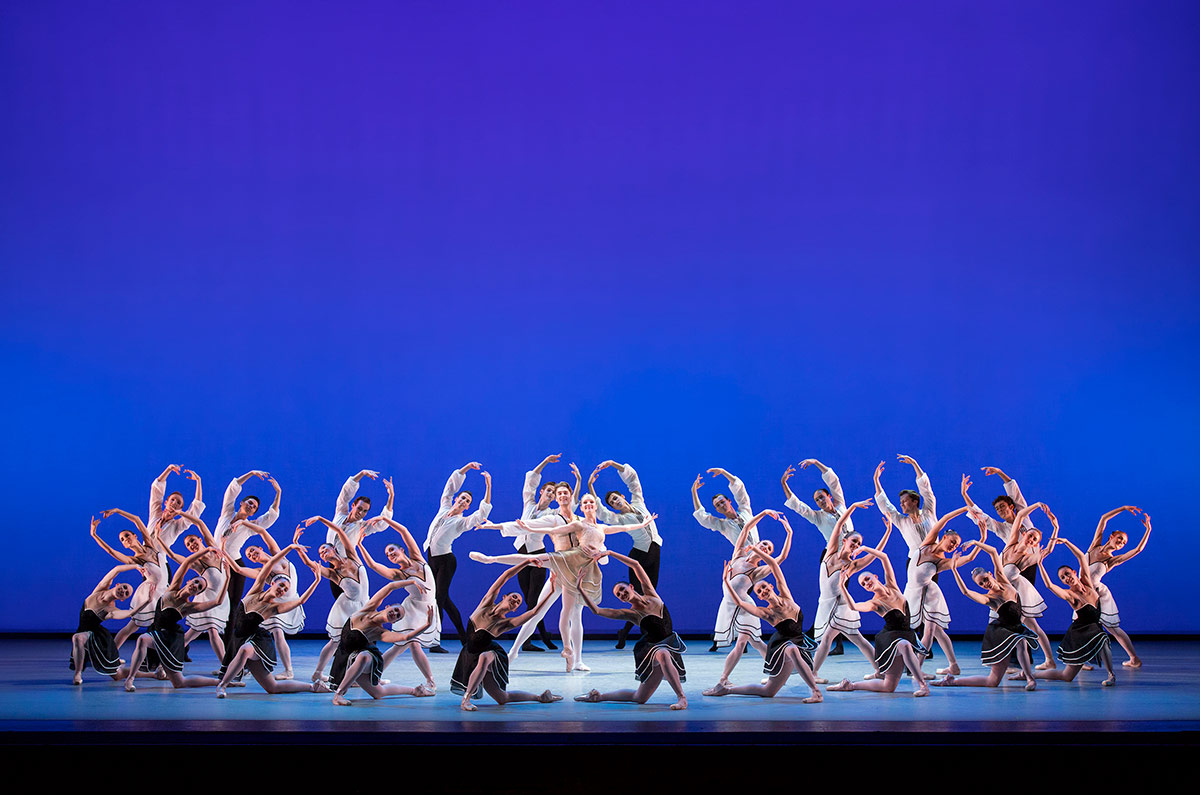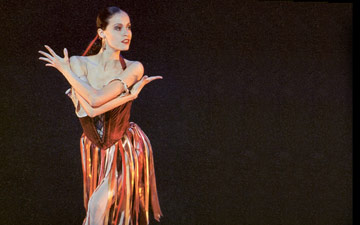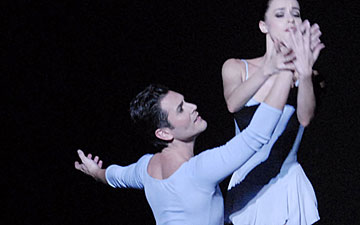
Image © Paul Kolnik. (Click image for larger version)
Suzanne Farrell Ballet
Forever Balanchine: Farewell Performances
Chaconne, Meditation, Tzigane, Gounod Symphony, Serenade
★★★★★
Washington, Kennedy Center Opera House
7, 8 December 2017
Feature on Suzanne Farrell Ballet’s Final Performances in Washington
Company Website
www.kennedy-center.org
The eminent American ballerina and muse of George Balanchine, Suzanne Farrell, after retiring from dancing career in 1989, has become a steadfast guardian of Balanchine’s heritage, teaching his technique and staging his works for ballet companies all around the world.
As artistic director of her own troupe, Farrell was able to take her devotion to Balanchine and her aspiration to promote and preserve his legacy to a new level. For nearly 20 years, Washington audiences have enjoyed an annual mini-festival of Balanchine’s works at the Kennedy Center, courtesy of The Suzanne Farrell Ballet.
From the start, Farrell has adapted a bold approach to her company’s programming. Never a safe bet, each season of Suzanne Farrell Ballet brought new fascinating discoveries of the Balanchine world, aiming not only to entertain but also stimulate, challenge and educate the audience. With great musical sensitivity and unique dramatic insight, Farrell staged his enduring masterpieces – Concerto Barocco, Serenade, Diamonds, Mozartiana, Divertimento No. 15, Emeralds, Liebeslieder Waltzer, Episodes, and Prodigal Son – giving them previously unseen luster and expressivity. She also gave new life to some of his rarely performed works – Pithoprakta, Bugaku, Ragtime, Divertimento Brillante, and Gounod Symphony – a unique showcase of Balanchine’s choreographic style and his musical tastes.
This season, the company said goodbye to its audiences with two programs which included ballets of particular significance to Farrell: Meditation, Tzigane, Chaconne, Gounod Symphony and Serenade. In each program, the enthusiasm and dedication of the dancers was abundantly displayed, as was a polished and fluent rendering of the choreography. In their final run, the company looked better than ever.

Image © Paul Kolnik. (Click image for larger version)
Both Meditation and Tzigane are short, character-driven and highly-theatrical pieces; both are exceptions to Balanchine’s traditional style of neoclassicism.
In Meditation (1963) – the first ballet Balanchine made specifically on Farrell – the choreographer alluded to his infatuation with Farrell, lamenting the fact that his greatest muse had entered his life some 30 years too late. Watching this dance, you realize what it feels like to love without hope.
Accompanied by the touching lyricism of Tchaikovsky’s Souvenir d’un Lieu Cher, Meditation shows a lone man on a dimly lit stage standing motionless as if frozen by grief, his face buried in his hands. A young woman in a white flowing dress, her hair unbound, appears onstage to console him. She gently embraces him and takes his hands in hers. What follows next is a whirlwind of unbound passion – a heart-stopping sequence of one rapturous embrace after another. There is not a trace of sentimentality here – just raw feelings of deep affection, anguish, despair and pain.
On opening night the graceful Elisabeth Holowchuk looked spectral and enigmatic as the main heroine. It seemed as if she was only a figment of the hero’s tormented imagination – a dream that was never meant to be. The superb Kirk Henning gave a credible portrayal of the grief-stricken lover, dancing with dramatic expression and ample skill, vividly translating into motion his protagonist’s besieged emotional inner world.
On the following night, Heather Ogden and Michael Cook delivered a performance of uninhibited passion and sweeping ardor, their amorous encounter brought to mind that of the famous Shakespearean star-crossed lovers.

Image © Paul Kolnik. (Click image for larger version)
Created to evocative dissonances of Ravel, the gypsy-themed Tzigane was meant to capitalize on Farrell’s theatrical-dance experience gained while working for nearly five years with Maurice Béjart in Brussels. The ballet premiered during New York City Ballet’s 1975 Ravel Festival and became a star vehicle for Farrell for the rest of her performing career. It’s an absorbing showpiece, full of angular gestures, exotic steps and dazzling theatricality. It’s also a marvelous realization of Ravel’s music in movement.
Dressed in a tantalizing red-and-gold fringed costume, Natalia Magnicaballi was spell-binding at every turn in her dramatic extended solo – part fortune-teller, part wicked witch, part alluring seductress. In her performance, she accentuated the choreography’s playful wit while delivering the highly-challenging steps with technical exactitude and aplomb. Her emotionally-charged dancing was equally matched by the rest of the cast.
The ethereal and courtly Chaconne (1976), to the music of Gluck from the opera Orpheus and Eurydice, was delivered with rare freshness and nuance. In Farrell’s intelligent staging, this ballet – particularly its second ensemble-driven part – acquired a wonderful sense of grandeur. Yet it is Chaconne’s meditative opening movement, with its poetic and tender duet to the famous Dance of the Blessed Spirits, what really melted one’s heart. Performed with appealing grace and musicality by Heather Ogden and Thomas Garrett, this pas de deux proved the undisputable highlight of the entire piece.

Image © Paul Kolnik. (Click image for larger version)
It was a real treat to be able to marvel at the astonishing choreographic intricacies of the newly-restored and sumptuously outfitted Gounod Symphony one more time. Farrell and her company brought this spectacular ballet to life last year as part of the Balanchine Preservation Initiative, a project that aimed to revive “lost” and rarely-performed pieces.
Balanchine began working on this ballet, inspired by Charles Gounod’s Symphony No. 1 in D Major, in the fall of 1957. It was a particular fruitful period in his career. At that time, in addition to Gounod Symphony, he was choreographing three new ballets: Square Dance, Agon, and Stars and Stripes – all of them still remain in New York City Ballet’s repertory. Gounod Symphony, however, fell into oblivion, having received its last performance by NYCB nearly 25 years ago. It’s a pity, for this work, with its visually stunning patterns and geometric interplays for the ensemble of 30 dancers (20 women and 10 men), reveal Balanchine’s architectural genius as never before.
Thanks to Farrell, this masterpiece got a second shot at life. The new costumes – black and white for the corps and golden for the principal couple – gave the entire work a clean, modern look and brought all the geometric intricacies to the fore. To watch Gounod Symphony danced by the Suzanne Farrell Ballet during both programs was to appreciate the glory of Balanchine anew – a precious gift to us all given by Farrell and her company.

Image © Paul Kolnik. (Click image for larger version)
The breathtaking performance of Serenade proved once again that only Farrell can elicit from her dancers such a level of musical intelligence, dramatic expressivity and emotional vulnerability that make the well-known choreography reverberate as never before. This was the most musical, the most poignant, the most spontaneous and vibrant performance of this beloved ballet in memory – a benchmark of style, atmosphere and execution.
Performances like this one, as well as many other unforgettable moments that Farrell and her company offered during their remarkable 16-year run at the Kennedy Center, will stay with Washington audiences for many years.

















You must be logged in to post a comment.